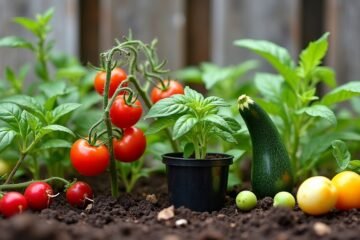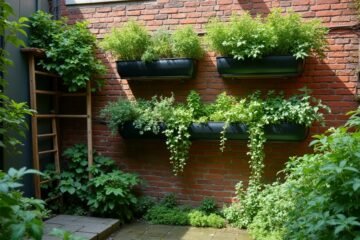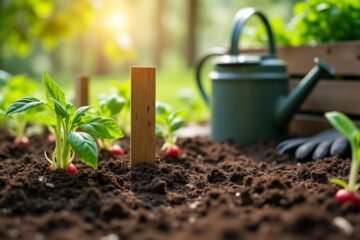Growing herbs in small gardens can be a delightful adventure! Start with compact plants like basil, chives, and thyme that fit snugly in tight spaces. Want to get clever? Try vertical gardening! Shelves and hanging pots instantly add flair while saving room. Pairing herbs can work wonders—like basil with tomatoes, which makes everything taste better! Keep your herbs thriving with quality soil and just the right amount of sunshine. Stick around, and you might discover more tips to elevate your garden!
Choosing the Right Herbs for Limited Space
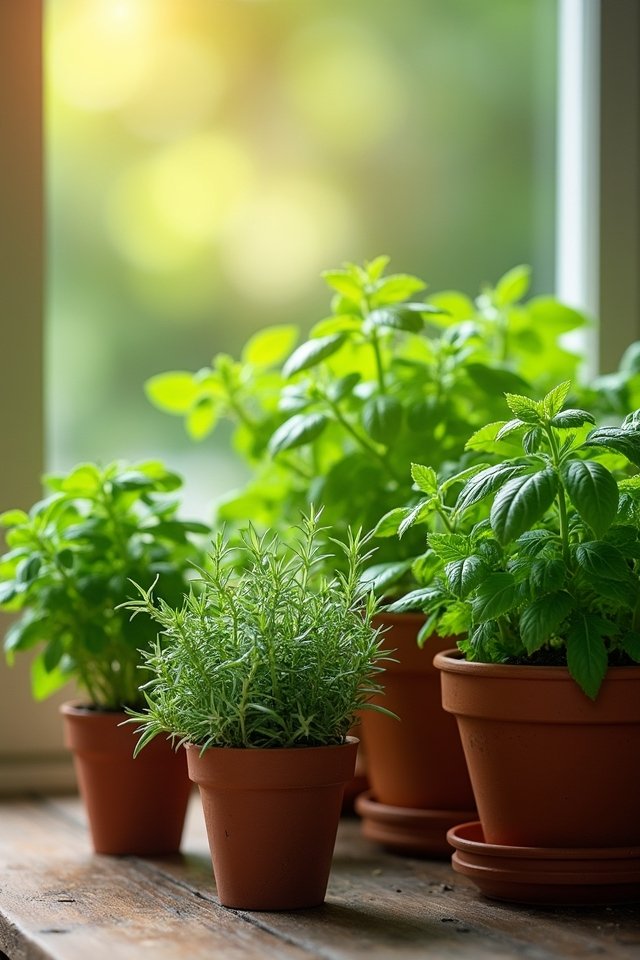
When you’re short on space but full of gardening dreams, choosing the right herbs can feel like a delightful puzzle! To achieve ideal herb selection, focus on compact varieties—think of them as power-packed flavor bombs! Basil, chives, and thyme thrive in tight spots, offering a dazzling array of tastes in just a few inches. Ever considered vertical gardening? You can hang pots or use tiered planters to maximize space. Loving fresh mint? It’s a powerhouse, too, but beware—it spreads like gossip! By selecting herbs with growth habits suited for small areas, you’re not just gardening; you’re crafting a flavorful potion. So, get creative and mix it up—tiny garden, limitless possibilities! Let your culinary dreams flourish right before your eyes!
Optimal Planting Techniques for Small Gardens
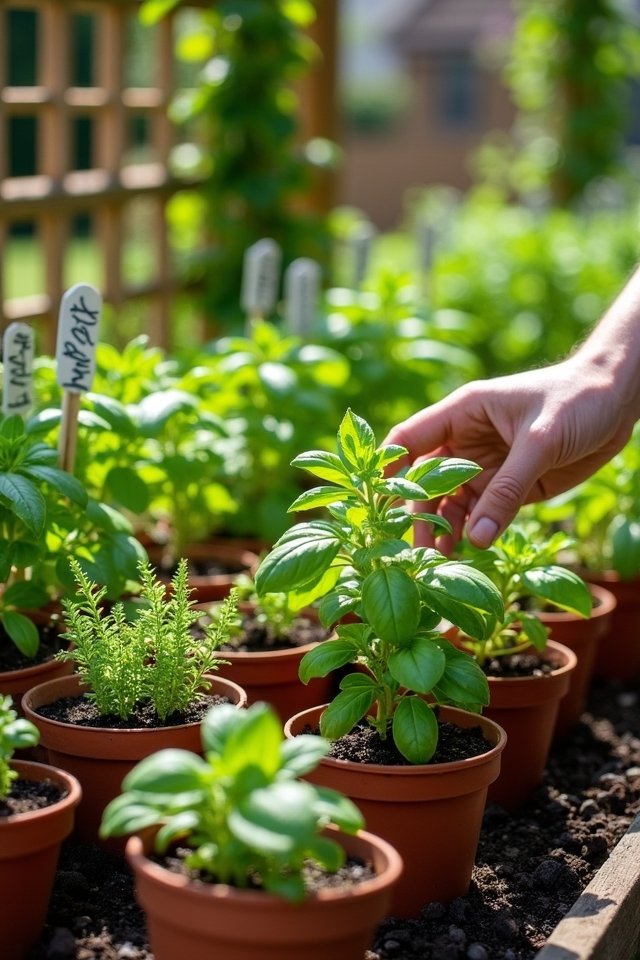
Ready to release your inner garden wizard? Let’s sprinkle some magic into your small space! First, pay attention to seed spacing. Crowding your herbs is like inviting too many guests to a dinner party—nobody has room to shine! Aim for about 6 inches apart for most herbs. Now, let’s talk vertical gardening! Think outside the box—literally! Use shelves, wall-mounted pots, or hanging planters to catch those sunrays and maximize your lovely garden. You’d be amazed at how a few vertical tricks can transform your compact oasis into a lush wonderland. Picture cascading mint and lively basil climbing skyward! With smart techniques like these, your herb garden will be the envy of your neighborhood. Happy planting!
Companion Planting to Maximize Growth
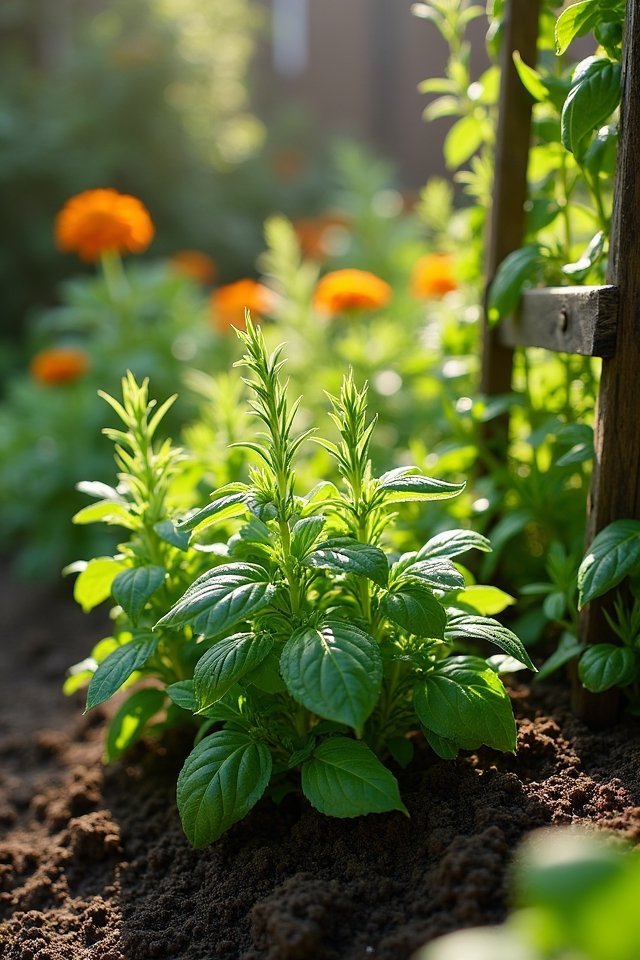
Companion planting can turn your small herb garden into a bustling, vibrant ecosystem, and who wouldn’t want that? By cleverly choosing herb pairings, you can reveal incredible plant benefits! For instance, basil loves cozying up with tomatoes. Not only will the basil enhance the tomatoes’ flavor, but it’ll also repel pesky pests. Meanwhile, mint and chamomile form a dynamic duo, boosting each other’s aromatic oils and flavors. Picture their fragrances intertwining on a summer day, delightful, right? And don’t forget about rosemary and sage! They thrive together, making your garden both visually appealing and productive. So, get creative! Explore these herb pairings to maximize growth, and watch your little garden transform into an herb bonanza! Who’s ready to get planting?
Container Gardening for Herbs

Have you ever thought about how easy it is to cultivate your own fresh herbs in containers? It’s like having a mini garden at your fingertips! Choosing the right herb varieties can spark your creativity, and using varied container sizes adds flair to your space. Here’s what to take into account:
- Herb Varieties: Go for basil, parsley, mint, or thyme—the possibilities are endless!
- Container Sizes: Use small pots for individual herbs or larger ones for multiple varieties.
- Drainage: Choose containers with holes; herbs hate soggy roots!
- Mobility: Move your containers to catch the sun—your herbs will appreciate it!
Ensuring Proper Sunlight and Watering
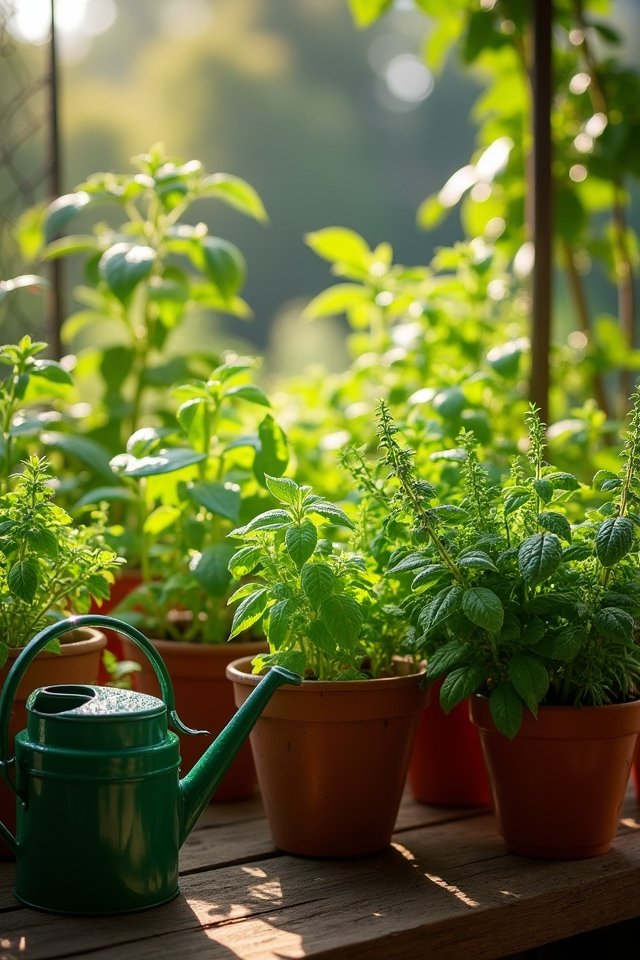
When you’re growing herbs, ensuring they get the right amount of sunlight and water is essential—after all, even the toughest rosemary needs a little TLC to thrive! Aim for at least six hours of sunlight exposure daily. If your garden’s a bit shady, consider moving your herbs to sunnier spots or using reflective surfaces to amplify the light. Now, let’s chat about watering frequency! The trick is to keep the soil moist, but not soggy—think of it like giving your herbs a revitalizing drink rather than a full-on spa day. Stick your finger about an inch deep; if it’s dry, it’s time to water. Trust me, your basil will perk up and thank you with vibrant green leaves!
Maintaining Soil Quality and Nutrients
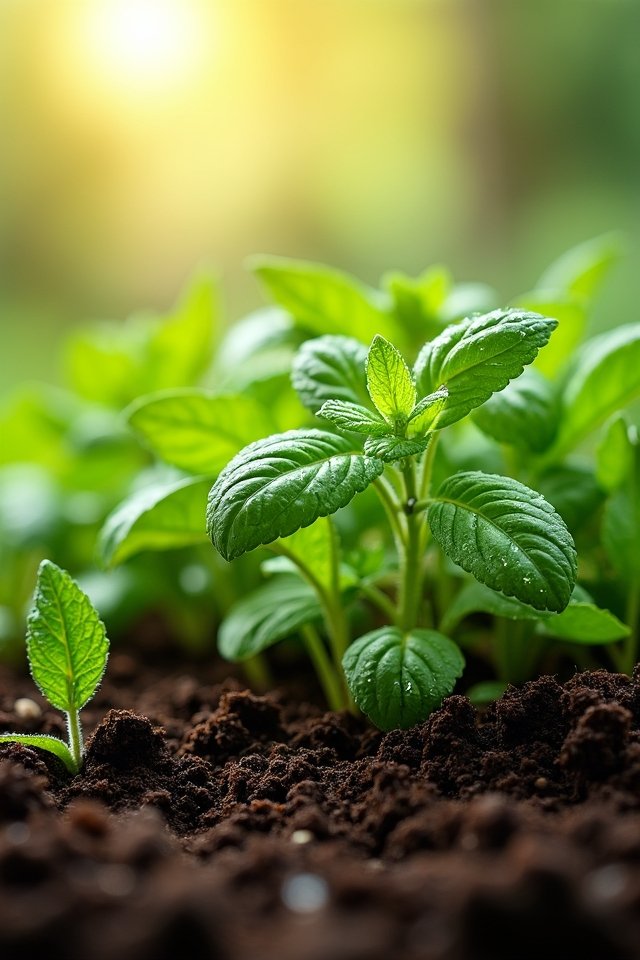
While you might think the secret to lush, flavorful herbs lies solely in sunlight and water, maintaining soil quality and nutrients is just as essential! Think of your garden as a gourmet restaurant; you need the right ingredients on the menu to delight your taste buds. To achieve that perfect nutrient balance, consider these four soil amendments:
- Compost: Rich in organic matter, it’ll enhance your soil’s texture.
- Worm castings: These tiny powerhouses are packed with nutrients.
- Bone meal: A fantastic source of phosphorus for stronger roots.
- Green manure: Plant cover crops to replenish nutrients naturally!
Harvesting and Pruning for Continuous Growth

Ready to keep your herb garden thriving? Pruning techniques are your secret weapon! Snipping off those leaves encourages bushy growth, so grab your scissors and go for it! But when are the best harvesting times? Plucking herbs in the morning, when their flavor’s at its peak, makes your dishes sing. Keep an eye on the leaves—if they start looking a tad too wild, it’s time for a trim! For example, rosemary and basil respond beautifully to a good haircut every few weeks. Just remember, you’re not just pruning; you’re nurturing. Each snip opens up more opportunities for fresh flavors. So, don’t be shy! Welcome the art of harvesting and watch your little herb kingdom flourish! 🌿
Frequently Asked Questions
How Do I Prevent Pests in My Small Herb Garden?
To keep pesky critters away from your small herb garden, you’ve gotta think smart! Use natural repellents like garlic spray or neem oil—think of them as your garden’s invisible shield. Plant marigolds nearby; they’re like nature’s bodyguards, warding off unwanted guests. If you catch those pests munching, just shake a little diatomaceous earth around! Who knew pest control could be this easy? Your herbs will thank you with delicious flavors!
Can Herbs Be Grown Indoors Successfully in Small Spaces?
You can totally thrive in indoor herb gardening with those small space solutions you’ve got. Picture a sunny windowsill brimming with vibrant basil and fragrant mint! Use clever containers or vertical planters to maximize your limited space. Herbs love light, so consider a grow light if natural sunlight is scarce. Trust me, the fresh smells and flavors will make your kitchen feel like a gourmet bistro! Ready to grow? Let’s do this!
What Herbs Are Best for Attracting Beneficial Insects?
Buzzing basil and charming chamomile can charm your garden! If you want pollinator-friendly herbs, try planting lavender, dill, and thyme. They not only smell scrumptious but also attract delightful bees and butterflies. Mixing these herbs with your veggies through companion planting makes your garden a vibrant oasis. Imagine butterflies dancing around—what a sight! So, go ahead and welcome these herbal heroes; they’ll bring life to your little green sanctuary!
How Do I Properly Store Harvested Herbs for Longevity?
You’ve got those fresh herbs, now how do you keep ’em vibrant and alive for ages? Try drying techniques like hanging them upside down; it’s like your herbs are getting a relaxing spa day! Want something quicker? Freeze ’em in ice cube trays with a splash of olive oil! It’s herbs on demand! Who wouldn’t want that? Just remember, whether drying or freezing, proper storage keeps the flavor bursting with deliciousness!
Are There Specific Herbs That Thrive in Shaded Areas?
Shade-loving herbs, like mint and lemon balm, flourish in those cooler corners of your garden. Imagine them basking in dappled sunlight while you sip invigorating tea! You can also try parsley and chives; their vibrant green leaves brighten up any space. Designing your herb garden to include these beauties makes it innovative and lively. So, why not get creative and welcome the shade? Your culinary adventures will thank you! Exciting, right?
